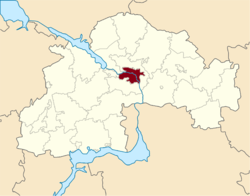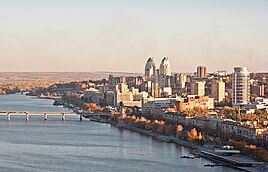Dnipro
Дніпро | |
|---|---|
City | |
| Ukrainian transcription(s) | |
| • Romanization | Dnipro |
| |
 Dnipro's location within Dnipropetrovsk Oblast | |
| Coordinates: 48°28′03″N 35°02′24″E / 48.46750°N 35.04000°E | |
| Country | |
| Oblast | Dnipropetrovsk Oblast |
| Raion | Dnipro Raion |
| Hromada | Dnipro urban hromada |
| Founded | 1776 (248 years ago) (officially[1]) |
| City Status | 1778 |
| Administrative HQ | Dnipro City Hall, 75 Akademik Yavornitskyi Prospekt |
| Districts | |
| Government | |
| • Type | City council, regional |
| • Mayor | Borys Filatov[2] (Proposition[2]) |
| Area | |
| • City | 409.718 km2 (158.193 sq mi) |
| • Metro | 5,606 km2 (2,164 sq mi) |
| Elevation | 155 m (509 ft) |
| Population (2022)[3] | |
| • City | 968,502 |
| • Rank | 4th in Ukraine |
| • Density | 2,411/km2 (6,240/sq mi) |
| • Metro | |
| Demonym(s) | Dniprianyn, Dniprianka, Dnipriany |
| Time zone | UTC+2 (EET) |
| • Summer (DST) | UTC+3 (EEST) |
| Postal code | 49000—49489 |
| Area code | +380 56(2) |
| Website | dniprorada.gov.ua |
Dnipro[a] is Ukraine's fourth-largest city, with about one million inhabitants.[4][5][6][7] It is located in the eastern part of Ukraine, 391 km (243 mi)[8] southeast of the Ukrainian capital Kyiv on the Dnipro River, after which its name is derived. Dnipro is the administrative centre of Dnipropetrovsk Oblast. It hosts the administration of Dnipro urban hromada.[9] Dnipro has a population of 968,502 (2022 estimate).[10]
Archeological evidence suggests the site of the present city was settled by Cossack communities from at least 1524. Yekaterinoslav ("glory of Catherine")[11] was established by decree of the Russian Empress Catherine the Great in 1787 as the administrative center of Novorossiya. From the end of the 19th century, the town attracted foreign capital and an international, multi-ethnic workforce exploiting Kryvbas iron ore and Donbas coal.
Renamed Dnipropetrovsk in 1926 after the Ukrainian Communist Party leader Grigory Petrovsky, it became a focus for the Stalinist commitment to the rapid development of heavy industry. After World War II, this included nuclear, arms, and space industries whose strategic importance led to Dnipropetrovsk's designation as a closed city.
Following the Euromaidan events of 2014, the city politically shifted away from pro-Russian parties and figures towards those favoring closer ties with the European Union. As a result of decommunization, the city was renamed Dnipro in 2016. Following the Russian invasion of Ukraine in February 2022, Dnipro rapidly developed as a logistical hub for humanitarian aid and a reception point for people fleeing the various battle fronts.[12][13]
- ^ Oleh Repan. The origins of Dnipro, the city and its name Archived 15 March 2022 at the Wayback Machine. The Ukrainian Week. July 2017 (page 46)
- ^ a b Результати 2 туру виборів у Дніпрі: розгромна перемога Філатова [Results of the 2nd round of elections in Dnipro: a devastating victory for Filatov]. 24 Kanal (in Ukrainian). 24 November 2020. Retrieved 24 November 2020.
- ^ The number of the available population of Ukraine as of January 1, 2022 (PDF)
- ^ Чисельність населення на 1 липня 2011 року, та середня за січень–червень 2011 року [Population as of 1 July 2011, and the average for January – June 2011]. Department of Statistics in Dnipropetrovsk Oblast (in Ukrainian). Archived from the original on 20 October 2013.
- ^ Общие сведения и статистика [General information and statistics]. gorod.dp.ua (in Russian). Retrieved 27 July 2019.
- ^ Ukrcensus.gov.ua — City Archived 9 January 2006 at the Wayback Machine URL accessed on 8 March 2007
- ^ "Official statistics, 01.08.2012 (Ukrainian)". Dneprstat.gov.ua. Archived from the original on 25 October 2014. Retrieved 28 November 2014.
- ^ "Coordinates + Total Distance". MapCrow. Retrieved 16 August 2015.
- ^ "Днепровская городская громада" (in Russian). Портал об'єднаних громад України.
- ^ Чисельність наявного населення України на 1 січня 2022 [Number of Present Population of Ukraine, as of January 1, 2022] (PDF) (in Ukrainian and English). Kyiv: State Statistics Service of Ukraine. Archived (PDF) from the original on 4 July 2022.
- ^ Cite error: The named reference
Cybriwsky History of the Dniprowas invoked but never defined (see the help page). - ^ Sullivan, Becky (29 March 2022). "With front lines on 3 sides, Ukraine's Dnipro sharpens its focus on the war". NPR.org. Retrieved 5 April 2022.
- ^ "Dispatch from Dnipro How 'Ukraine's outpost' and its people are faring after one year of all-out war". Meduza. 23 February 2023. Retrieved 11 April 2023.
Cite error: There are <ref group=lower-alpha> tags or {{efn}} templates on this page, but the references will not show without a {{reflist|group=lower-alpha}} template or {{notelist}} template (see the help page).







